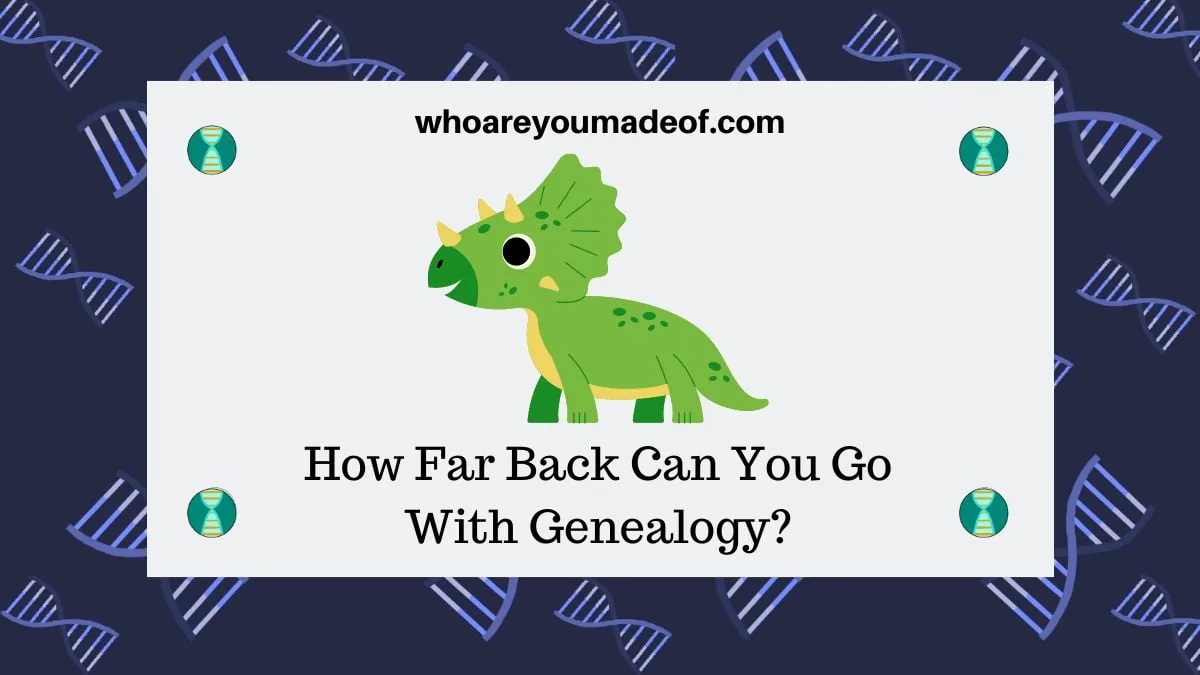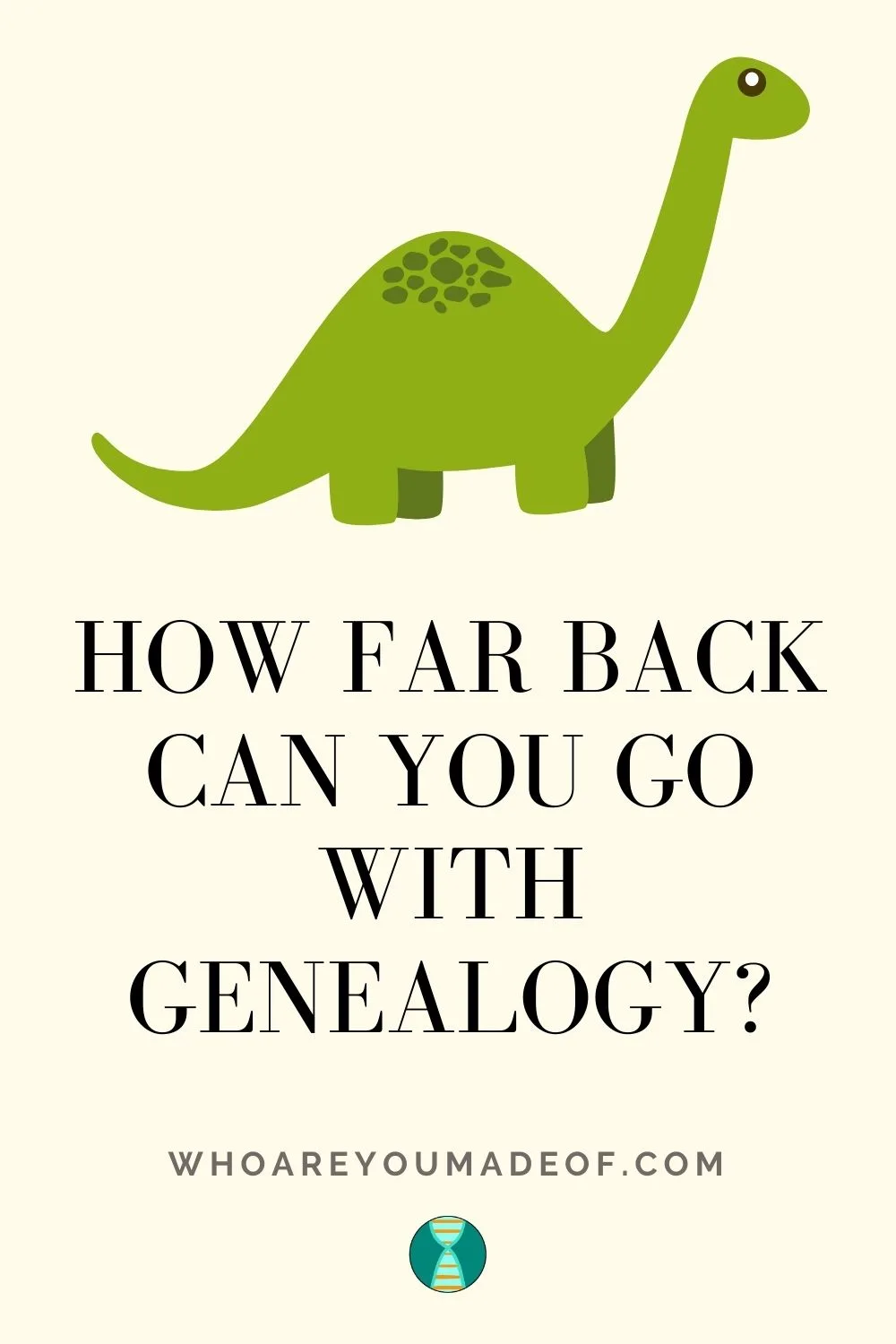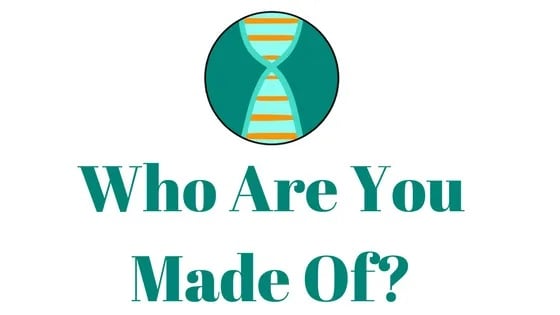If you've been into genealogy or genetic genealogy for a while, you've probably heard someone say that they have traced their ancestry back to William the Conqueror (d. 1087), Julius Caesar (d. 44 BC), or even Adam and Eve. While most of us will be skeptical, it can lead us to wonder how far back you can really go with genealogy?
And how far back would we really want to go?
In this post, I'll discuss the following related topics:
- How far back is it possible to go in genealogy
- Can DNA help you go back further in history than traditional genealogy?
- Some people who we believe to be our ancestors aren't really related to us

Most family tree researchers strive to make sure that our research is accurate, and accuracy is one reasons that many people who are interested in family tree research decide to take DNA tests. Whether or not you think accuracy really matters, it is interesting to ponder how far back you can realistically (and accurately) build a family tree.
In other words, is your neighbor's family tree that she claims goes all the back to Charlemagne accurate? And if it could be accurate, does it even matter, especially since he might have more than a billion descendants?
How far back is it possible to go in genealogy?
How far back can we actually build our family tree? While we can build our family trees back as far as we want to, what we really want to know is how far back can we accurately build our family trees?
The answer to this question is a concise "it depends".
How far back we can really build our trees back depends on many factors including their religion, race, social class, place of birth, culture, and luck. In order to build our trees, we need documentation and evidence, and whether or not said documentation and evidence exists depends on some of those factors I just mentioned.
It takes luck to build a family tree really far back
In order to get evidence for our trees, we need luck. Bad luck is what I would call the 1890 census records being destroyed in a fire or church records being burned in a vengeful conflict.
Good luck is finding a full-page article in an old newspaper detailing our great-great-great grandfather's life and death. Our ancestors needed to be lucky enough to have the socioeconomic resources to have records created about them, or have unlucky circumstances create a life of infamy, and we need to be lucky enough to find those records.
The records themselves also need to be "lucky" to survive centuries without being damaged.
Family tree records depend (a lot) on religion
Each religion has different customs of record keeping, and sometimes those customs vary by country or culture. Sometimes, religious organizations were the only institutions keeping records in a particular area in a given time period, and so religious records would only pertain to those people who practiced that religion.
The wealth or fame of our ancestors affects whether we can learn about them
Even though written records of events like births and deaths of "regular people" have been kept in some places since about the year, not every birth and death was recorded in places where records were kept.
The race, social class, or socioeconomic status of a person had a lot to do with whether or not important events in their lives were recorded in an official manner, or whether society in general felt that it was important to document noteworthy aspects of their lives.
An extreme example? If our 10th great-grandfather was the King of England, we are more likely to find out lots of details about his life than we would if he were the servant cleaning the king's bedchambers.
Modern record-keeping and use of surnames helps track ancestors
Some of our ancestors might have been born in places were no records were kept. Others might have been born in places where no surnames were used until just a few hundred years ago.
How far back can the average person trace their family tree
As you can see, how far we can accurately build our tree back really does depend on a lot of different factors.
Most people will be able to trace some lines of their family tree back to the 1600s. Some people might be able to trace a few lines of their tree back a little further than that, especially if they have a very notable person in their family tree that has had a lot of independent research done about them.
This means that some people might be able to trace some aspects of their tree back to as far as about 1400, which would be considered unusual. Most serious genealogists would view a tree that goes back to the year 1400 with a large dose of skepticism.
There are some exceptions to this generalization, however. For example, the Icelandic culture is famous for its detailed genealogies.
It is said that "everyone" in Iceland knows their genealogy, and that some are able to trace their ancestry back as many as 30 generations.
Can DNA help you go back further than traditional genealogy?
DNA testing is excellent for assisting in breaking down brick walls in your tree closer than about 6-8 generations ago, but it won't be much help in figuring out who your 11th great-grandmother's biological father really was.
I like to suggest that autosomal DNA testing can help us absolutely verify our recent ancestry and can help us feel fairly sure about our ancestry going back about 6-8 generations.
Even though DNA testing can't help us go further back in our family tree than traditional genealogy can, it does help build our tree's foundation. I would hate to spend years researching my family tree only to later find out that I had the wrong great-great-great grandfather in one line of my tree.
Once I am sure about all of my recent ancestors, I can spend time building my tree farther back and feel more confident about its accuracy.
Some of our ancestors aren't really related to us
One important aspect of accuracy in a family tree is the occurrence of "non-paternity events". Every once in a while, a father unknowingly (or sometimes knowingly, but it isn't recorded anywhere) raises a child who is not biologically related to him.
This is rare, but does occur in about 1 out of 100 births, on average. It happens more in some cultures than others, and has been more common in certain time periods than others.
This means that if you consider that we have about 1000 8th great-grandparents, meaning that there were about 500 marriages that took place among that generation of your ancestors. This could mean that as many of five of your great-great-great-great-great-great-great grandparents have the "wrong" father listed on their birth record or church record.
While I can't tell you whether or not this really happened in your family, I can tell you that it's very likely that it happened at least once at some point. How often it happened would depend on your family's history.
While DNA testing can help sort some of this out, we can safely assume that everyone who has a large family tree has a "wrong" person (or several) in their tree somewhere.
How far back do you really want to go in your family tree?
Have you ever heard that almost anyone is your 16th cousin? This is a statement that oversimplifies the idea, but essentially, we are probably related to almost anyone we know at about a 12-20th cousin level.
If we calculate the common ancestor shared with a sixteenth cousin, we will realize that we are both descended from the same 15th great-grandparents.
Yes, that's great-great-great-great-great-great-great-great-great-great-great-great-great-great-great grandparents. You might also be interested to know that we have about 65,000 different 15th great-grandparents, unless we have significant pedigree collapse in our family tree at that level (which we probably do!).
What being a "16th" cousin" to everyone else really shares the same common ancestors as you going back that far in their tree. Translation: everyone else is descended from your ancestors, too.
If we go back far enough, we would find that we are all related.
The reason that I think that it is important to bring this up is because as we move further back in our tree, our connection to those very distant ancestors can be less meaningful for many of us because we share it with so many people. For example, many people are very proud about being descended from someone who was on the Mayflower.
Did you know that as many as 35 million people are descended from the Mayflower immigrants? That's about 10% of the population of the United States that is descended from someone who was on that boat.
If you consider that very few of those 35 million Mayflower descendants would actually share detectable DNA with their immigrant ancestor, it becomes less significant. It is not my intention to single out this particular group, but it is a very good example.
The same concept is true for any particular set of ancestors that far back in time. They might have millions of descendants!
A few months ago, I was explaining to my children about a notable set of 11th great-grandparents in their family tree. Immediately, one of them said "Hmmmmm, I wonder how many other people are descended from them, too?"
Quite right, there are an estimated few million other people who can also claim them as ancestors.
I always think it is more exciting to research my connection to my more recent ancestors and learn as much about them as I can. After all, we share our more recent ancestors with much fewer people!

Conclusion
I hope that this post answered your question about how far it is possible to go back in a family tree. I would love to know how far back your family tree goes, or if you agree or disagree with my assessment of how far back it's really possible to build a tree.
Please leave a comment in the discussion below 🙂
Thanks for stopping by!

Joan Kwasiborski
Tuesday 27th of May 2025
On the Useful Charts youtube channel, the narrator for the Merovingian Dynasty, comments that the known relative of Charlemagne, Saint Arnold [Arnulf] of Metz, is the furtherst back that researchers are confident is a legitimate ancestor for Charlemagne. Narrator doesn't seem to think one can confidently go back further than St. Arnold of Metz. He does include in that Merovingian presentation people they think go back further, but they don't have the documentation that they like. St. Arnold of Metz is about 582-645 AD. ~ one of my large family groups did have a DNA project, which showed our great-grandfather of 1710 was born out of wedlock. The person we had believed to be his father, was his grandfather, and the person we thought to be his sister, was the mother. The biological father was revealed, which led to the discovery that through the biological father, we are related to President Barrack Obama. Yes, having DNA results can be a big help.
Wurr
Tuesday 15th of April 2025
This used to have a short video that went with it that I would show students. Is this still available?
Mercedes
Sunday 20th of April 2025
Hi, Thank you for your comment! I am sorry, I had recently removed the video, but I will add it back. I'm glad it has been helpful to your students! Sincerely, Mercedes
Norma
Saturday 30th of November 2024
My father’s maternal side was extremely rich but lost all of their money and vast properties (but not connections) during the Mexican Revolution (early 1900s). Would that make it easier to trace my roots further because of their immense wealth? Where should I look, are there resources online? I also tested both my dad’s and my DNA, (mostly, but not all European). I’m wondering if this aspects would make it easier to figure out? Please advise. Thank you!
Terry Williams
Monday 26th of August 2024
Thank you so much for your insight, I share much of your skeptimisim (?) I couldn’t spell check it! Using Ancestry.com and various other record’s including Google, My 3 times GGF Thomas Williams married Elizabeth Tudorboth born in 1775, in Kinnerly Shropshire England I have a copy of their marriage certificate for around 1795 from memory. The Williams tree sadly is only traceable another four generations, but of course the Tudor line is much easier, even allowing discrepancies. By the way I have a dna result of 92% Welsh, 6% middle England & N.W. France, 1% Scottish, & Norwegian. I followed it back to about 1400 when Owen Tudor Married the young Widow of King Henry V, Princess Catherine De Valois of France. Owens line goes back via the Welsh connections, to most of the Welsh “Kings/ Lords (Probably War Lords), defending agains the new coming tribes of Saxon, etc. Catherine’s side goes back up the DeValois tree to the Capets, as “ a Cadet Branch”? They in turn their founder Hugh Capet, Count of Paris, King of the West Franks, married one of King Alfred the Greats Grand Daughters Eatheled, half sister of King Athelstan. That’s where my research has gone, I am just so aware of being hopelessly wrong, as by jumping to conclusions and false assumptions that everything is just so!
Roger
Sunday 11th of June 2023
I went back to Adam and eve. My family was former royal family of Britain. They're the gruffud. It took Me like 3 days of research . I used only the father of the previous generations to go to Adam and eve